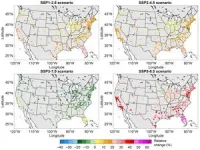(Press-News.org) A research study led by University of Oklahoma assistant professor Chenghao Wang and recently published in the journal Nature Communications tackled the critical issue of how city-scale building energy consumption in urban environments will evolve under the influence of climate change.
Fossil fuels account for approximately 40% of all building energy use in urban city centers in the United States, and the U.S. Energy Information Administration reports that residential and commercial buildings in U.S. cities are one of the major energy consumers (39%) and greenhouse gas emitters (28%).
“Understanding their future energy use is very important for developing climate change mitigation strategies, improving energy efficiency, developing and implementing energy and environmental regulations, policies, and incentive plans and enhancing the resilience and adaptation of our society under future climate and extreme weather conditions,” said Wang, who leads the Sustainable Urban Futures, or SURF, Lab in the OU School of Meteorology.
“Previous studies made strides in estimating how energy use might change at the national or state levels in response to future changes in climate,” he said. “However, there is a significant gap in our understanding when it comes to the city scale. As global cities commit to ambitious sustainability goals, a more granular understanding of energy use at the city scale becomes imperative.”
The research team includes Janet Reyna and Henry Horsey from the National Renewable Energy Laboratory, Jiyun Song, Dachuan Shi and Yuyu Zhou from the University of Hong Kong, Sarah Feron from the Universidad de Santiago de Chile, Zutao Ouyang and Robert Jackson from Stanford University, and Ying Li from China Three Gorges University.
They examined 277 cities across the contiguous U.S., using model simulations and the most recent future climate projections from the Coupled Model Intercomparison Project, or CMIP6, dataset. They considered four possible warming scenarios that encompass a variety of possible climate warming scenarios and two electric power sector scenarios.
“In one power sector scenario, we assumed no future carbon policies would be implemented, but we also included a scenario that assumes rapid decarbonization and net-zero carbon emissions from the power sector by 2050, similar to with U.S. carbon-pollution-free goals announced by President Biden in 2023,” Wang said.
To investigate how urban building energy use would evolve under future climate change, Wang’s team used an indicator called energy use intensity, or EUI. The EUI is the energy used per square foot per year and is calculated by dividing the total energy consumed by the buildings by their total gross floor area.
“Due to climate change, we found that city-scale building EUI is projected to experience uneven changes by the 2050s when compared to the 2010s,” Wang said. “The largest increase in electricity EUI will mainly occur in the South, Southwest, West, and Southeast, which will see an increase of up to 7.2%.”
They discovered that the increase in electricity EUI during warm seasons and the hottest days will be much greater than the annual change, especially in the Northwest. This difference is mainly due to the higher air conditioning adoption rate and space cooling energy use under future warming. For each degree of warming, the average city-level space cooling EUI will increase by 13.8%.
“We found an average 10.1 to 37.7% increase in the frequency of urban summer peak building electricity EUI. However, some cities will experience over 110% increases. This will require higher grid capacity and also greater resilience against power outages during extreme heat waves,” Wang said.
The team also assessed the potential changes in the source energy used by urban buildings, considering energy losses during generation, transmission and distribution.
“Power sector decarbonization is very effective in curbing the source energy consumption of future buildings in cities, but it’s crucial to further reduce direct fossil fuel combustion in buildings,” Wang said. “Simply put, we need rapid electrification for future urban buildings.”
Learn more about Wang’s research through the Sustainable Urban Futures Lab at the University of Oklahoma.
###
About the Research
The study, “Impacts of Climate Change, Population Growth, and Power Sector Decarbonization on Urban Building Energy Use,” published Oct. 18, 2023, in Nature Communications. DOI 10.1038/s41467-023-41458-5
The Data Institute for Societal Challenges at the University of Oklahoma provided funding for “Integrating Multiple Datasets to Develop a Historical Comprehensive Hourly Urban Weather Database for Energy System Modeling,” a study that expands the hourly weather database developed in this paper.
About the University of Oklahoma
Founded in 1890, the University of Oklahoma is a public research university located in Norman, Oklahoma. As the state’s flagship university, OU serves the educational, cultural, economic and health care needs of the state, region and nation. OU was named the state’s highest-ranking university in U.S. News & World Report’s most recent Best Colleges list. For more information about the university, visit www.ou.edu.
END
Sweden is far ahead when it comes to promoting open access to scholarly publications. But there is risk of getting stuck in a permanent transformation that favours large commercial publishers. A new report from the Association of Swedish Higher Education Institutions develops a strategy on how to work in negotiations with the publishers.
In 2021, the Association of Swedish Higher Education Institutions (Sveriges universitets- och högskoleförbund, SUHF) convened a “Beyond transformative agreements” working group (the BTA group) to lay the foundation for further advancing the transition to open access. Now, the group ...
The use of e-scooters has increased significantly in recent years, but so has the number of accidents involving this relatively new form of transport. At the same time, knowledge about injury mechanisms in this area was still very limited. In the project SURF, funded by Zukunftsfonds Steiermark, the Vehicle Safety Institute at Graz University of Technology (TU Graz) investigated this topic using Human Body Models and derived recommendations to reduce the injury risk in e-scooter accidents.
Put on a helmet, decrease speed and get off the pavement
As ...
Research conducted by marine biologists from the University of Sydney has found juvenile crown-of-thorns starfish can withstand tremendous heatwaves well above levels that kill coral. These starfish then develop into carnivorous predators that devour reefs just as they begin to regrow.
Crown-of-thorns starfish are native to the Great Barrier Reef and found in the Indo-Pacific region, but they are classified as a species of concern because the damage large populations cause to coral is more significant than any other species. ...
Research published in the Journal of Internal Medicine indicates that SARS-CoV-2 infection may worsen lower urinary tract symptoms (LUTS) in men.
The study included 17,986 men receiving medication for LUTS within the public healthcare system of Hong Kong in 2021–2022, half of whom had SARS-CoV-2 infection. The group with SARS-CoV-2 had significantly higher rates of retention of urine (4.55% versus 0.86%); blood in the urine (1.36% versus 0.41%); clinical urinary tract infection (4.31% versus 1.49%); bacteria in the urine (9.02% versus 1.97%); and addition of 5-alpha reductase inhibitors, which are drugs prescribed for enlarged prostate. (0.50% versus 0.02%). These urological ...
New research published in Economic Inquiry reports substantial increases in psychological distress in the UK during the first wave of the COVID-19 pandemic.
Mental health effects were more pronounced for females; younger individuals; Black, Asian, and minority ethnic communities; and migrants. Also, people who had financial worries, loneliness, or were living in overcrowded dwellings experienced significantly worse mental health deterioration during the first wave.
The study used data from the UKHLS, also known as Understanding Society, which is a household panel dataset that captures, among other things, information from adults about their economic and social circumstances, ...
Population outbreaks of the crown-of-thorns sea star (COTS), a predator of coral, can cause widespread coral mortality. COTS are herbivorous as juveniles but then switch to coral consumption as they grow to adulthood. When researchers exposed juvenile COTS to heat stress scenarios at time and temperature durations designed to reflect conditions that cause coral bleaching and mortality, juveniles exhibited tolerance to heatwave conditions well above levels that kill coral.
The findings, which are published in Global Change Biology, indicate that juvenile COTS are likely to persist as major coral predators in reefs already vulnerable to the effects of climate change.
“This ...
The various neurological symptoms that patients with COVID-19 have experienced suggest that viral infections may increase the risk of neurodegeneration, which could in turn contribute to the development of conditions such as Alzheimer’s disease (AD). A review in the Journal of Neurochemistry highlights the potential mechanistic links between COVID-19 and AD.
The authors note that age is the largest contributing factor to AD and COVID-19, and both appear to enhance the effects of the other, with potentially synergistic effects on neurodegeneration.
“I believe over the next several ...
Agricultural management has typically focused on increasing yields, but there is an increasing need for sustainable food production that limits negative impacts on the environment. A new study published in Grassland Research provides insights into the potential benefits of diversifying agricultural practices, revealing how different mixtures of plant species can improve production, quality, and conservation.
For the study, investigators planted multiple species in different grassland plots, manipulating plant species richness from one to six species spanning three functional groups ...
Identifying different types of body fluids can help forensic experts reconstruct a crime scene, but it’s difficult to do so. In a study published in Electrophoresis, researchers developed a method using two different types of RNA—called microRNA (miRNA) and messenger RNA (mRNA)—to determine five common body fluids.
Compared with previously reported single mRNA or miRNA assays, the combination of several mRNAs and miRNAs showed significant advantages for labeling human body fluids.
“Our findings indicate that this combined mRNA and miRNA system may provide a scientific ...
It is often claimed that using the snooze button can have negative effects on sleep and cognitive processes, but there has been no direct evidence to this effect. New research from the Department of Psychology at Stockholm University shows that snoozing may actually support the waking process for regular snoozers.
It's common to want to stay in bed, potentially even go back to sleep, when the alarm goes off in the morning. The snooze button has been a function in alarm clocks and cell phones for decades and is ...






